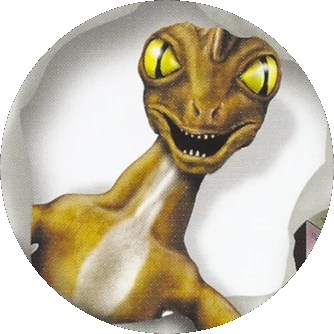|
"Only now do we know the true story- Megarachne was a giant prehistoric sea scorpion." |
Living in scorching deserts and dry grasslands, the golden jackal survives by being a trickster. Normally, this predator has little problem using its big ears and incredible endurance to find and kill prey. When food is hard to find, though, the jackal follows lions to share in their kills, or even enlists the help of a cheetah to take down a victim it couldn't tackle by itself. These animals live in a tight family unit, and adult jackals are great parents.
What Was That? A set of large, rounded ears makes hearing the best of the golden jackal's senses. This animal can hear the movement of prey from dozens of yards away, and will track a victim by sound until it's in sight.
Never Stop: The golden jackal's long legs and slim but muscular body make it an excellent long-distance runner. The creature wears down victims by chasing them at a steady pace, then sprints in for the kill when the prey is too tired to fight.
A Helping Hunt[]

While these hyenas feast, a jackal looks to snag a bite.
The golden jackal will eat almost anything it finds, from rabbits and lizards to small insects, carrion and even fruit. Like any predator, however, and deer. This hunter has it prefers bigger meals, such as gazelle no problem making its own kills, but sometimes works as a team with other predators if a meal will be big enough to share. The jackal runs after prey, chasing it toward a cheetah or leopard that's waiting to spring an ambush. The jackal buries any meat it can't finish so it can be eaten later.
Steal-a-Meal: If food is scarce, the golden jackal sometimes follows lions, hyenas or other predators around. After they make a kill, the jackal sneaks up and tries to steal some meat.
Family Guy: Jackals form loyal family groups. The male brings food to the pregnant female and fiercely protects her against all intruders. Both care for the young, and some pups even stay around to help raise the next litter.
Death in the Afternoon[]
- A pair of hungry jackals hears the sounds of potential prey, so they follow the noise until they spot a female gazelle. A young gazelle is hidden by the tall grass.
- The adult gazelle takes off to lead the jackals away from her baby (fawn), but the fawn reveals itself, giving each jackal a different target to chase.
- The young gazelle isn't fast enough to outrun the jackal. When one jackal brings it down, the other gives up its chase of the mother to join in the easy meal.
Trading Card[]
Trivia[]
- As of 2015, the canid known as the golden jackal was split in two; the Eurasian species of golden jackal is still known as Canis aureus, while the ones which reside in Africa are now classified as the African wolf (Canis lupaster). Since the card’s “Where?” section lists both regions, it effectively covers both species.
- Because of this change, the golden jackal is the second wolf featured in the Nightmares of Nature, after the Gray Wolf.
- The card's front illustration is used on the back of Anubis's card, where it discusses why his head is based on the Golden Jackal.
- The card's front illustration is also used in the Wildlife Explorer series's profile on the Golden Jackal. Like most cards, the only change is the removal of terrain beneath the Jackal's feet, and flipping of the image like the Lynx.
- The image of the jackals eating with the hyenas, and the "Death in the Afternoon" images are also shared; in the latter, now titled "Hunting Safari", there is a second image of the jackals spotting the baby with its mother, and the images specify the gazelles are Thomson's gazelles (Eudorcas thomsonii).
- There are two references in the mini headings on the back of the card:
- First is "Family Guy", most likely a reference to the cartoon of the same name.
- The second is "Death in the Afternoon", which is the title of a 1932 Ernest Hemingway book, and also a cocktail which Hemingway is credited with creating.
- The golden jackal is featured in Tricky Treat on Monster Mania 93.
